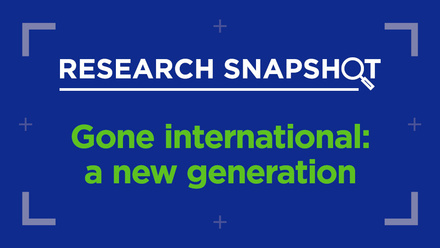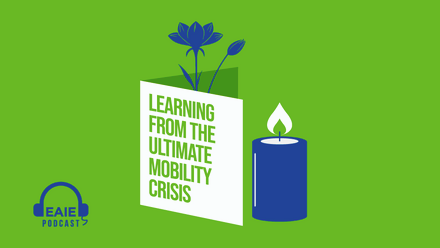The future of student mobility is hybrid

This last EAIE Summer Forum week post wraps up our reflections on the theme of ‘Mobility in the balance’ by looking at the power of hybrid and blended learning technologies to compensate for the loss of international student mobility.
As much as we are all tired of the prolonged stay-at-home orders put in place to curb the spread of the COVID-19 virus, in higher education we have seen a significant number of ways in which technology has finally been allowed to bring about the disruption predicted as early as 10 years ago by authors such as American economist Clayton Christensen.
In short, we have been given an opportunity to address and, with the right leadership and determination, resolve some of the crises that have plagued higher education for many years.
Mobility among students, staff and faculty has been one of the most important gains of the past few decades of relative political, social and economic stability in many (albeit far from all) places around the world. Over the past 30 years, the frenzy of international education travel has only occasionally and briefly been stopped by terrorist incidents such as 9/11 and by natural disasters including the Tōhoku earthquake and tsunami of March 2011 in Japan.
A lucrative business
Overall, humans have been travelling internationally more than ever before. But not all of us. Too many of us have still been bound to our places of origin by a lack of economic opportunities or by political or social unrest. Meanwhile, global mobility for degree-seeking students has proved to be an especially lucrative business for recruitment agencies and universities alike. Higher education institutions from Australia and New Zealand to the UK and the United States have come to rely to varying degrees on the revenue generated by international students’ tuition fees and campus living expenses.
Educational mobility and the additional streams of revenue it has brought to universities worldwide have created the perfect environment for tertiary education institutions to postpone dealing with the numerous and varied crises that have been looming since the late 2000s. Back then, the global economic depression combined with ageing populations in developed economies created an increased need for institutions to compete for students.
That competition had a dual consequence: on one hand, it forced universities to push more and more expensive marketing and recruitment strategies, add more staff and offer more perks with hidden costs to stay relevant and attract students. On the other, it transformed degrees and diplomas into commodities. Significant parts of the higher education system worldwide have become transactional, mercantile, with institutions selling a product purchased by consumer students.
The initial wishful thinking that we will return to the pre-pandemic reality in higher education is slowly fading away.
Rethinking priorities
As the benefits (and compromises) brought about by our new digital reality become more evident in the second year of the pandemic, one other thing is becoming increasingly clear: the initial wishful thinking that we would return to the pre-pandemic reality in higher education is slowly fading away. A flurry of digital conferences, webinars, symposia and workshops have occupied the first half of 2021 with strategies, solutions and opinions about higher education digitalisation.
It has already been convincingly argued that we should no longer aim for a ‘return’ and that we ought to use the pandemic as an opportunity to reform an education system that has not kept up with the times and was turning into yet another unfair benefit for students with privilege and economic means. I tend to agree that rather than trying at all costs to return to a pre-pandemic ‘status quo’, we should look forward. And global educational mobility should be no different.
The time is right to re-evaluate what is worth retaining from all the in-person recruitment of international degree-seeking students; year-long, semester-long and faculty-led study abroad programmes; international internships; and in-person cross-institutional and industry–academia research collaborations. And no, we need not eliminate all of them completely. But we can certainly rethink our priorities, make the curricular offerings more focused, make the interactions with peers on the ground shorter and more productive, and use more hybrid means to teach and collaborate prior to actually getting on a plane to fly 200 or 2000 miles across the world.
In doing so, we will also contribute to the reduction of our carbon footprint as an industry – that elephant in the room that we never quite address properly at our large international education conferences. After all, are we ready as international educators to take it upon ourselves to justify being part of the ongoing human-caused deterioration of the environment in the name of additional tuition revenue – or in the name of networking that can, as we have seen for 12 months now, be done quite easily within a digital environment?
First steps
So what can we do to continue to give our students the opportunity to experience other linguistic, political, social and cultural paradigms, to allow researchers to work toward solving issues through international collaborations and to empower universities to work with world corporations for mutual benefit? It is true that we do not currently have a better way to understand others than by immersing ourselves in a place and its community and allowing our senses to be overwhelmed by what is new and different, usually only to conclude that we are all, ultimately, motivated by similar concerns.
A first solid step should be, in my opinion, the enhancement and active promotion of hybrid and blended learning methodologies. Every faculty-led mobility programme should have a prerequisite of at least one course taken in Collaborative Online International Learning (COIL) format in collaboration with a local university prior to departure. No semester abroad programme should proceed without extensive interactions with students and administrative offices on the ground (and no, the brief orientations we currently do are not sufficient).
Improving access
Nothing I suggest here is novel. The resources to engage in this direction are already in place and they have shown great results for students especially. For the past three years, I have had the opportunity to be part of two extraordinary initiatives: the advisory council for the collaborative US–Japan Higher Education Engagement Study; and the external advisory council for three Japanese universities participating in the Trans-Pacific COIL for the Multiculturalism and Conflict-Resilience Project, sponsored by the Japanese Ministry of Education, Culture, Sports, Science and Technology.
Through these projects, I have come to see the extraordinary impact that international collaborative digital courses, events, workshops, conferences and other virtual collaborations have on students in Japan, the US and elsewhere. One of the most impactful testimonials I heard about the importance of COIL, for instance, came from a US professor at the University of California. She highlighted the importance of digital international learning for her students who would otherwise never have been able to work side by side with peers from Japan because their families could not afford the expenses necessary for a physical trip across the world.
And that is not an isolated example of the limitations imposed by the old model of educational mobility. The concept of ‘study away’ in the US, for example, originated within the same reality: the extreme financial difficulties that US college students face every day to the point where many campuses are forced to manage food pantries to ensure that their students (and sometimes students’ families) don’t go hungry.
In Europe, despite the overall growth of Erasmus since its inception, the programme’s 2015 report clearly shows that on average, only about 10% of students in participating countries are able to study abroad. One can easily imagine that a major role in the overall low participation is played by untenable costs of living in many parts of western Europe (the study destination of choice), which make it virtually impossible for central, eastern and southern European students, as well as many northern and western Europeans, to take part in the programme.
To help level the playing field, then, the future of global educational mobility not only should be hybrid but must be hybrid. Moreover, an increase in fully digital international education opportunities is crucial, if for no other reason than to allow more and better access to global experiences and opportunities for that higher education group without whom there would be little to no reason for our field to exist: the students.






